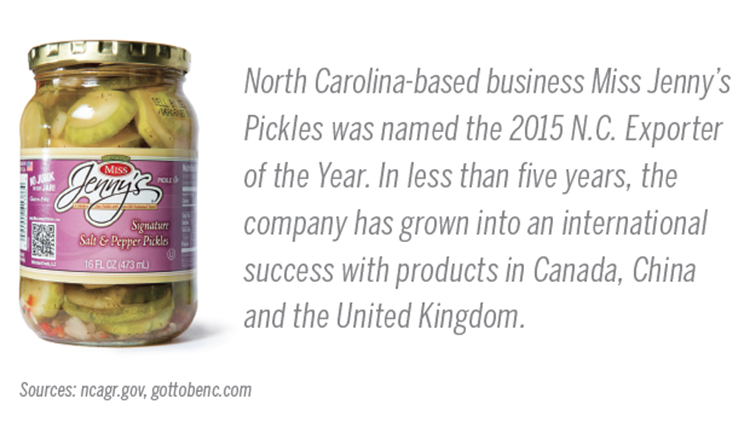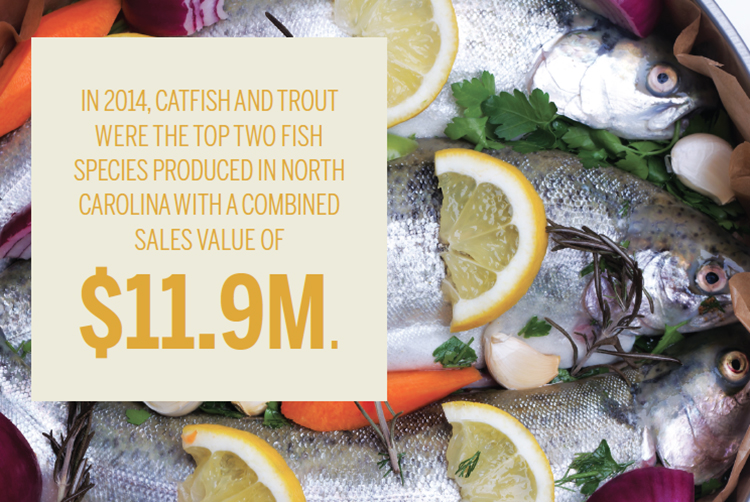Home > North Carolina > North Carolina Crops & Livestock > North Carolina Agriculture
North Carolina Agriculture
In partnership with: North Carolina Department of Agriculture & Consumer Services

North Carolina’s booming agriculture industry is as varied as the state’s geography. From the towering Appalachian Mountains to the Coastal Plain, North Carolina’s climate and landscapes allow for a bounty of agricultural products.
The state ranks first in the nation in farm cash receipts for tobacco and sweet potatoes; second for poultry and eggs; and third for pork and trout.
Along with these commodities, North Carolina’s hardworking farmers produce cotton, soybeans, peanuts, hogs and pigs, nursery products, aquaculture products, and more.
But North Carolina agriculture is more than just commodities. Agritourism, agricultural exports, healthy eating incentives and research are just a few of the other aspects of the state’s industry.
About 49,500 farms spread across 8.4 million acres of land across the state, with each farm averaging about 168 acres in size. All these farms strongly contribute to agriculture’s economic impact on North Carolina, which rings in at $76 billion annually. Governor Pat McCrory plans to increase North Carolina’s agriculture and agribusiness impact to $100 billion annually by 2020 with the help of the Food Manufacturing Task Force, which was created to help reach the goal by creating more jobs in agriculture.
The task force consists of 35 members with expertise in various sectors of agriculture such as crop production, agribusiness, food processing and packaging, transportation, and more. The team will help develop a strategic plan to leverage existing food manufacturing companies, foster the growth of food manufacturing entrepreneurs, focus on new business development and increase training, among other goals.
All these aspects together – North Carolina’s commodity production, agricultural innovation and planned growth – encompass the mission relayed in the North Carolina Department of Agriculture and Consumer Services’ tagline: “Grown, Raised, Caught, Made. Got To Be NC.”
![North Carolina ag [INFOGRAPHIC]](https://eadn-wc01-4177395.nxedge.io/wp-content/uploads/2020/02/Screen-Shot-2015-11-20-at-3.15.35-PM-2.jpg)
N.C. Grown
From peanuts to blueberries to turfgrass, North Carolina agriculture is an abundance of fresh produce, important row crops, and beautiful flowers and plants. The “grown” aspect of NCDA&CS’s tagline encompasses all of these key commodities that rely on specific types of soil, climate and expert grower knowledge to flourish.
Five crops make an appearance in North Carolina’s top 10 commodities, including tobacco, sweet potatoes, soybeans, corn and cotton. Tobacco, the top “grown” commodity for the state, had a production value of more than $900 million in 2014.
North Carolina’s principal crops generated a production value of more than $4.2 billion in 2014. The crops include many fresh products consumers might find at the local farmers market, such as sweet potatoes, cucumbers, strawberries, tomatoes, bell peppers and squash.

N.C. Made
While North Carolina’s agricultural commodities and livestock are extremely diverse, the state’s industry encompasses agribusinesses and food processing companies that are equally as important.
Major national brands such as Krispy Kreme Doughnuts, Snyders-Lance, Mt. Olive Pickles and more are headquartered in the Old North State. These corporations, as well as smaller agribusinesses that make products such as gourmet candies, sauces and marinades, jams and jellies, baked goods, and others, are all part of the “made” aspect of North Carolina Department of Agriculture’s tagline.
Local goods can be easily spotted with the “Got to Be NC” logo, which is part of the Goodness Grows in NC program, working to promote and market local North Carolina products.
N.C. Raised
The most valuable sector of North Carolina agriculture, “raised” refers to the state’s animal agriculture including poultry, hogs, horses, cattle, turkeys and more. The production value numbers are impressive: $3.85 billion for broilers, $2.85 billion for hogs and $419 million for cattle and calves.
The state also ranks No. 2 in the nation for production of hogs and pigs, and cash receipts for poultry and eggs.

N.C. Caught
North Carolina aquaculture is one of the state’s fastest growing agriculture segments thanks to the state’s prime geographic location and its Coastal Plain region. Encompassing the “caught” part of the state’s tagline, North Carolina aquaculture includes catfish, trout, tilapia, striped bass, crawfish, freshwater prawns, blue crabs and other shellfish, and more. North Carolina is second only to Idaho in trout production.
Annually, aquaculture contributes close to $25 million to North Carolina’s economy in farm sales alone, and research is ongoing to provide growers with the knowledge needed for success.
Consumers reap the benefits of this industry as well, with lots of local seafood available at North Carolina restaurants and markets for them to enjoy.




Hi I am looking to buy a tiny farm in North Carolina – possibly berries or crop of some kind. But i cannot find a realtor savy enough to help me. please tell me how i can find such a mini farm? Thank you, Kathleen
ammann2u@yahoo.com